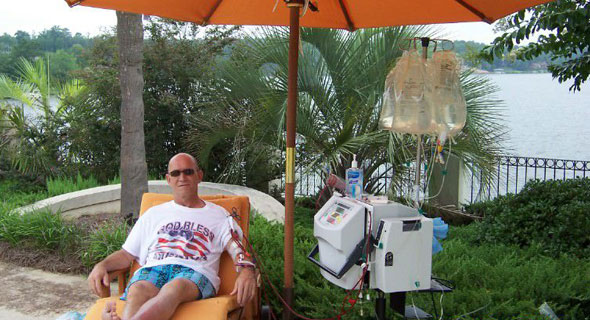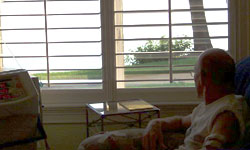
About Rick
| Treatment Type | Daily Home Hemodialysis |
| Gender | Male |
| Age | 50s |
| Marital Status | Married |
| Kids | No / Not at Home |
| Work Status | Working |
| Race | White |
| Pets | No |
| Cause | Unknown |
| Travel | Yes |
| Poor Vision | No |
"I don't want dialysis to control my life," says Rick. "I'd rather control the dialysis." The desire to be "in control" prompted Rick to start doing his dialysis at home in 1998. And, it has motivated him to do what it takes to stay at home in spite of some obstacles over the years.
Deciding to go home

In late 1997, Rick was under the care of a nephrologist for chronic kidney disease. He'd planned to get a transplant before he needed to start dialysis. Those plans fell by the wayside when a blood clot caused his kidneys to shut down suddenly. He needed to start dialysis right away.
Like many people who have to start dialysis in a crisis, he had a catheter placed in his neck and had his first treatments in the hospital. "It was overwhelming," relates Rick. "On the first day, so many people came by to tell me things: the diet, the treatments, and everything that was going to happen. At the end of the day, I just looked at my wife and said, 'what were they all talking about?'"
Rick did remember one thing from that first day. Someone said that dialysis could be done at home. Rick and his wife wanted to try it. For 6 months, though, Rick dialyzed in-center on Monday, Wednesday, and Friday of each week. He kept his job as a Customer Service Supervisor, and talked to his doctor about home training. When the school year ended in June, and his wife had time off, they started the 6-week home hemodialysis (HD) training.
A series of changes
Rick and his wife learned to run the machine, and put in the needles. They turned their grown son's old bedroom into a "medical room," and did treatments there 3 days each week. Then, they got some bad news about their water supply. "Somehow the well that supplied our neighborhood got contaminated," reports Rick. "The city black-flagged our water." So, Rick chose to try peritoneal dialysis (PD).
Rick trained to do PD, and did it for several months. During that time, he did both manual and cycler exchanges so he could get enough dialysis and keep his job. "I'd do an exchange in the morning and go to work, then come home at lunch to do another exchange," he says. In the evening, he'd do one more exchange and then use the cycler at night. Unfortunately, Rick developed a problem with his colon and had to have his PD catheter removed.
Once again, Rick had to make a change, this time back to in-center HD. He disliked the rigid schedule and had problems with his access. "The staff infiltrated my graft often," he says. "One time it was so bad that my access was completely clotted off." That episode convinced Rick to make two more changes: (1) to put in his own needles, and (2) to go back to home HD.
By this time, the city had fixed his water, and he was able to start home HD again. He used a Baxter 1550 (an upgrade to his old Baxter 550), and did three treatments per week for several years.
New opportunity
In 2004, Rick heard about an Indiana University study of a new home dialysis machine. He began training on the NxStage machine that same year. "They scheduled 10 weeks for training," recalls Rick, "but we knew how to set up the machine by the third day. It was pretty easy."
Now Rick dialyzes 6 days a week, for about 2 hours each day. He likes the shorter, more frequent treatments. "I think if you added up all the hours, it would be about equal to doing home HD 3 days a week, but I'm only in the chair a couple hours each day." Rick also likes the fact that he can fit his 2-hour treatments into his day. "If we want to go out to dinner with friends," he comments, "I might do my treatment in the morning or after I get home." The shorter timeframe allows lots of flexibility. "We've got control back now," he adds.
Feeling good
Rick also likes how well he feels with daily treatments. "I don't think of myself as a sick person," he claims, "because I just don't feel sick." The biggest thing he notices is the lack of swings in fluid levels. "Your weight is stable," he points out, "and you don't get that washed out feeling after a treatment." Rick has found such a difference in fluid management on daily HD that he sometimes has to remind himself to drink more water! "Over the years I got so used to watching my fluids, and now they want me to drink," he says. "Sometimes I have to drink a glass of water before I start my treatment!"
In the first week of daily HD, Rick was able to stop all his blood pressure medicines. He also has few, if any, leg cramps as part of his treatments. Daily HD has also improved his appetite. In fact, Rick's appetite is so good that he needs to take 6 phosphate binders now instead of 4 with each meal.
"I've done every kind of dialysis there is," he comments, "and none comes close to making me feel the way this one does. It's pretty close to having a kidney."
Frequent traveler
Since Rick has been doing daily home HD, he has taken trips—and likes being able to take his machine with him. All you need to run the machine is a power outlet and the bags of dialysate. He can do his dialysis almost anywhere.
Over the Christmas holiday, Rick and his wife took a cruise—not a special dialysis cruise. "I called the cruise line's special needs office and told them I would be doing HD. They didn't believe I could do it myself," he chuckles. "I had to get a letter from NxStage stating that the equipment was portable. I also had to get a letter from my doctor saying that I was trained and wouldn't need medical help," he adds. "Once they got the proof, they were very helpful. My dialysate bags were brought right to the ship and put in our room, and we took the machine with us." Rick and his wife did the daily HD in their cabin after a full day's activities.
Rick has also taken his machine on trips to visit relatives and friends. "One time I just did my dialysis in the game room," he admits. "Everyone was watching a movie, eating popcorn and doing things that families do, and I was doing my dialysis. When the movie was over, I was done with my treatment." The ease of travel now contrasts sharply with Rick's previous dialysis travel.
"When I traveled on standard in-center HD, I had to call ahead and schedule a treatment time in a center. They always give you a time in the middle of the day. And, then you're so tired after your treatment that you don't feel like doing anything. So, you lose 3 days of your trip," he explains. Now, he can fit his treatments into his vacation plans.
Well-suited to home dialysis
For Rick, home HD is the way to go. "I didn't like someone telling me when I had to be someplace—with no choice about it," he asserts. "I like to be in charge of my time, and now I am." His flexible schedule has allowed him to return to part-time work in merchandising and marketing, and he plans to stay active.
"Nobody wants to have kidney failure," admits Rick, "including me. But I decided years ago that I could handle this thing two ways. I could feel sorry for myself—or I could be the best patient I can be. I decided to be the best patient...and that's what I'm trying to be."

